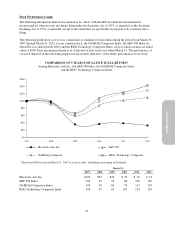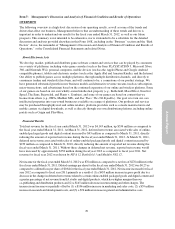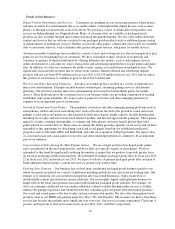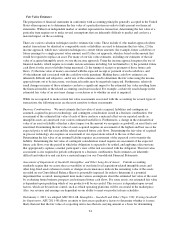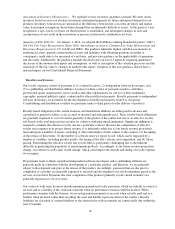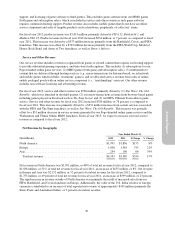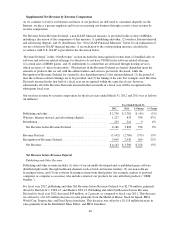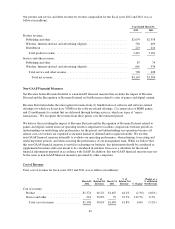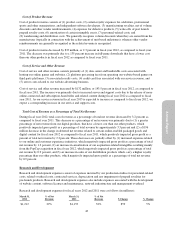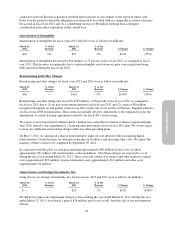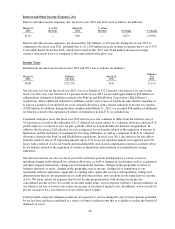Electronic Arts 2012 Annual Report Download - page 120
Download and view the complete annual report
Please find page 120 of the 2012 Electronic Arts annual report below. You can navigate through the pages in the report by either clicking on the pages listed below, or by using the keyword search tool below to find specific information within the annual report.Assessment of Inventory Obsolescence. We regularly review inventory quantities on-hand. We write down
inventory based on excess or obsolete inventories determined primarily by future anticipated demand for our
products. Inventory write-downs are measured as the difference between the cost of the inventory and market
value, based upon assumptions about future demand that are inherently difficult to assess. At the point of a loss
recognition, a new, lower cost basis for that inventory is established, and subsequent changes in facts and
circumstances do not result in the restoration or increase in that newly established cost basis.
Adoption of ASU 2011-04. On January 1, 2012, we adopted the FASB Accounting Standards Update (“ASU”)
2011-04, Fair Value Measurement (Topic 820): Amendments to Achieve Common Fair Value Measurement and
Disclosure Requirements in U.S. GAAP and IFRSs. The guidance limits the highest-and-best-use measure to
nonfinancial assets, permits certain financial assets and liabilities with offsetting positions in market or
counterparty credit risks to be measured at a net basis, and provides guidance on the applicability of premiums
and discounts. Additionally, the guidance expands the disclosures on Level 3 inputs by requiring quantitative
disclosure of the unobservable inputs and assumptions, as well as description of the valuation processes and the
sensitivity of the fair value to changes in unobservable inputs. Adoption of this new guidance did not have a
material impact on our Consolidated Financial Statements.
Royalties and Licenses
Our royalty expenses consist of payments to (1) content licensors, (2) independent software developers, and
(3) co-publishing and distribution affiliates. License royalties consist of payments made to celebrities,
professional sports organizations, movie studios and other organizations for our use of their trademarks,
copyrights, personal publicity rights, content and/or other intellectual property. Royalty payments to independent
software developers are payments for the development of intellectual property related to our games.
Co-publishing and distribution royalties are payments made to third parties for the delivery of products.
Royalty-based obligations with content licensors and distribution affiliates are either paid in advance and
capitalized as prepaid royalties or are accrued as incurred and subsequently paid. These royalty-based obligations
are generally expensed to cost of revenue generally at the greater of the contractual rate or an effective royalty
rate based on the total projected net revenue for contracts with guaranteed minimums. Significant judgment is
required to estimate the effective royalty rate for a particular contract. Because the computation of effective
royalty rates requires us to project future revenue, it is inherently subjective as our future revenue projections
must anticipate a number of factors, including (1) the total number of titles subject to the contract, (2) the timing
of the release of these titles, (3) the number of software units we expect to sell, which can be impacted by a
number of variables, including product quality, the timing of the title’s release and competition, and (4) future
pricing. Determining the effective royalty rate for our titles is particularly challenging due to the inherent
difficulty in predicting the popularity of entertainment products. Accordingly, if our future revenue projections
change, our effective royalty rates would change, which could impact the amount and timing of royalty expense
we recognize.
Prepayments made to thinly capitalized independent software developers and co-publishing affiliates are
generally made in connection with the development of a particular product, and therefore, we are generally
subject to development risk prior to the release of the product. Accordingly, payments that are due prior to
completion of a product are generally expensed to research and development over the development period as the
services are incurred. Payments due after completion of the product (primarily royalty-based in nature) are
generally expensed as cost of revenue.
Our contracts with some licensors include minimum guaranteed royalty payments, which are initially recorded as
an asset and as a liability at the contractual amount when no performance remains with the licensor. When
performance remains with the licensor, we record guarantee payments as an asset when actually paid and as a
liability when incurred, rather than recording the asset and liability upon execution of the contract. Royalty
liabilities are classified as current liabilities to the extent such royalty payments are contractually due within the
next 12 months.
36



